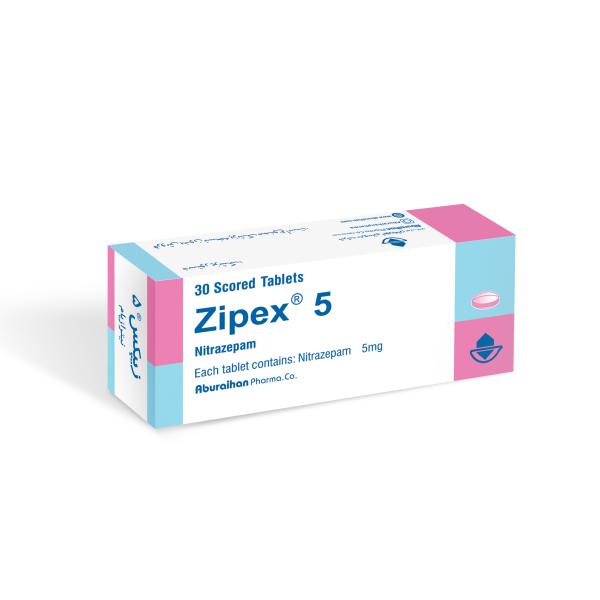Zipex®
Nitrazepam
tablet
Insomnia, sleep onset or sleep maintenance: Short-term treatment and symptomatic relief of insomnia characterized by difficulty in falling asleep, frequent nocturnal awakenings, and/or early morning awakenings.
Seizures: Management of myoclonic seizures in children.
Mechanism of Action:
Binds to stereospecific benzodiazepine receptors on the postsynaptic GABA neuron at several sites within the CNS, including the limbic system, reticular formation. Enhancement of the inhibitory effect of GABA on neuronal excitability results by increased neuronal membrane permeability to chloride ions. This shift in chloride ions results in hyperpolarization (a less excitable state) and stabilization. Benzodiazepine receptors and effects appear to be linked to the GABA-A receptors. Benzodiazepines do not bind to GABA-B receptors
Method of Administration:
Insomnia, sleep onset or sleep maintenance: 5 to 10 mg once daily at bedtime, as needed.
Myoclonic seizures: Infants and Children ≤30 kg: Oral: Usual dosage: 0.3 to 1 mg/kg/day in 3 equally divided doses; if doses are not divided equally, administer larger dose at bedtime.
Notes
Hypersensitivity to nitrazepam, benzodiazepines, or any component of the formulation; myasthenia gravis; severe respiratory insufficiency (eg, significant sleep apnea syndrome); severe hepatic insufficiency; use as hypnotic in children
Interactions:
Alcohol (Ethyl): CNS Depressants may enhance the CNS depressant effect of Alcohol (Ethyl). Risk C: Monitor therapy
Buprenorphine: CNS Depressants may enhance the CNS depressant effect of Buprenorphine. Management: Consider reduced doses of other CNS depressants, and avoiding such drugs in patients at high risk of buprenorphine overuse/self-injection. Initiate buprenorphine at lower doses in patients already receiving CNS depressants. Risk D: Consider therapy modification
CloZAPine: Benzodiazepines may enhance the adverse/toxic effect of CloZAPine. Management: Consider decreasing the dose of (or possibly discontinuing) benzodiazepines prior to initiating clozapine. Risk D: Consider therapy modification
CNS Depressants: May enhance the adverse/toxic effect of other CNS Depressants. Risk C: Monitor therapy
Melatonin: May enhance the sedative effect of Benzodiazepines. Risk C: Monitor therapy
Metoclopramide: May enhance the CNS depressant effect of CNS Depressants. Risk C: Monitor therapy
Pramipexole: CNS Depressants may enhance the sedative effect of Pramipexole. Risk C: Monitor therapy
Zolpidem: CNS Depressants may enhance the CNS depressant effect of Zolpidem. Management: Reduce the Intermezzo brand sublingual zolpidem adult dose to 1.75 mg for men who are also receiving other CNS depressants. No such dose change is recommended for women. Avoid use with other CNS depressants at bedtime; avoid use with alcohol. Risk D: Consider therapy modification
Pregnancy and Lactation:
Teratogenic effects have been observed with some benzodiazepines; however, additional studies are needed.
Drowsiness, lethargy, or weight loss in nursing infants have been observed in case reports following maternal use of some benzodiazepines. Breastfeeding is not recommended.
Warning and Precaution:
- Anaphylaxis/anaphylactoid reactions: Have been reported with use (rare); patients who develop angioedema should not be rechallenged with nitrazepam.
- Anterograde amnesia: Benzodiazepines have been associated with anterograde amnesia
- Aspiration pneumonia: Bronchial hypersecretion and excessive salivation/drooling leading to aspiration pneumonia in young and elderly patients may occur rarely.
- CNS depression: May cause CNS depression, which may impair physical or mental abilities; patients must be cautioned about performing tasks which require mental alertness (eg, operating machinery or driving).
- Paradoxical reactions: Paradoxical reactions, including hyperactive or aggressive behavior, have been reported with benzodiazepines; risk may be increased in adolescent/pediatric patients, geriatric patients, or patients with a history of alcohol use disorder or psychiatric/personality disorders.
- Rebound insomnia: Following withdrawal of therapy, transient insomnia may recur accompanied by other reactions including restlessness, anxiety, and mood changes.
- Sleep-related activities: Hazardous sleep-related activities such as sleep-driving, cooking and eating food, and making phone calls while asleep have been noted with benzodiazepines
Adverse Reactions:
Cardiovascular: Hypotension, palpitations
Central nervous system: Aggressive behavior, agitation, amnesia, ataxia, confusion, delusions, depression, disorientation, dizziness, excitement, falling, fatigue, hallucination, hangover effect, headache, hyperactivity, irritability, lethargy, myasthenia, nervousness, nightmares, outbursts of anger, psychosis, restlessness, sedation, staggering, withdrawal syndrome (chronic use)
Dermatologic: Dermatological reaction
Endocrine & metabolic: Change in libido
Gastrointestinal: Constipation, diarrhea, heartburn, nausea, sialorrhea, vomiting
Hematologic & oncologic: Granulocytopenia, leukopenia
Hepatic: Abnormal hepatic function tests
Hypersensitivity: Anaphylaxis (or anaphylactoid reaction; angioedema, dyspnea, nausea, pharyngeal edema, vomiting)
Neuromuscular & skeletal: Muscle spasticity
Ophthalmic: Blurred vision
Respiratory: Aspiration, dyspnea, increased bronchial secretions
Storage:
Store below 30ºC and protect from light and moisture.

